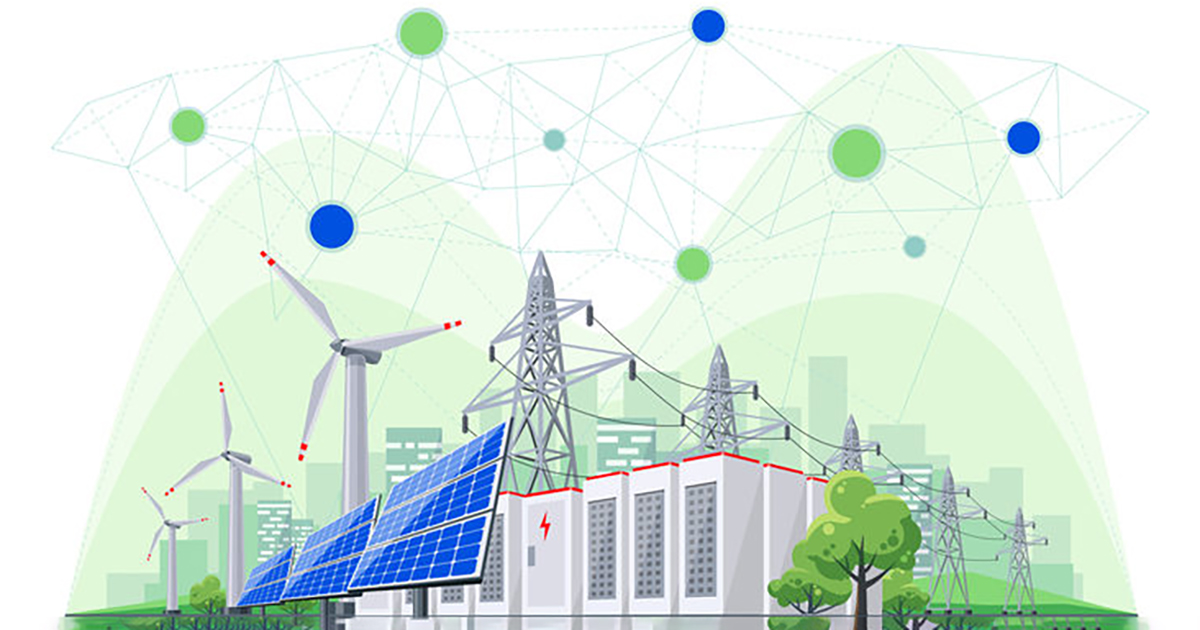The North American electric grid is an immense feat of engineering and often referred to as the largest and most complex machine in the world. When we discuss ‘the grid’ we are typically referring to the entire system in the abstract, including all the power plants, wires, and related equipment that deliver electricity to our homes and businesses every day.
But electrical networks can come in all shapes and sizes to meet the particular needs of diverse customers and communities. And there are meaningful distinctions in the terminology used to describe these different networks, like supergrid, minigrid, microgrid, nanogrid, and, of course, just ‘the grid’.
There are at least a dozen different ways to build, operate, and quantify an electric system — from a single building to networks that cover entire countries or even transnational regions — and each classification has a role to play in the integrated electricity network of the future.
Let’s take a look at some of the most common types and the ways we are all impacted by the rapidly evolving electric grid.
UNDERSTANDING
The Grid (and Minigrids)
A grid, in essence, is any combination of power sources, end customers, different wires to connect it together, and centralized controls to make it all work.
Typically a grid is made up of the following components:
- Generation sources (fossil fuels, nuclear, solar, wind, etc)
- High-voltage transmission lines to carry power long distances
- Distribution lines to reach individual customers
- Substations that integrate the transmission and distribution networks
A grid can be subdivided into smaller operating regions, whether that be for individual utility territories, multi-state competitive marketplaces, or other independent networks. Grids are also oftentimes layered — an individual utility grid that is also part of a regional market — and are typically linked together into larger interoperable systems.
In the continental US, we subdivide the entire network into three distinct grids — the Eastern Interconnection, the Western Interconnection, and the independent Texas Interconnection. Each of these grids operate independently of each other with limited sharing of power between them.
A ‘minigrid’ is a term used to quantify the size and scale of a grid, but otherwise has the same components described above, except most likely does not have any transmission lines used to move power long-distance since it has a smaller footprint. Minigrids typically stand alone and operate independently, but they can also be linked together into a network of minigrids similar to the US network of three ‘full-size’ grids.
There are often minor discrepancies between the particulars of these definitions between international groups and individual countries’ own terminology. These differences stem from how these different grids are deployed and the priorities and perspective of the organization’s making the designation.
The UN Framework Convention on Climate Change defines a minigrid as an independent network with a power rating below 15 MW (roughly 3,000 US homes), but that is not a hard and fast metric by any means. The more inclusive US definition of a minigrid is similar, but is not limited to being fully independent from other networks.
Minigrids are most often deployed to serve isolated or rural communities, remote industrial operations like mining, or small island populations where connecting to a larger grid is either technically impractical or too cost-prohibitive.
With this foundation of understanding in hand we can describe some of the other common types of grids, which are mostly defined in relation to this centralized grid concept.
understanding
Microgrids and Nanogrids
Here is the US Department of Energy’s microgrid definition:
A microgrid is a group of interconnected loads and distributed energy resources within clearly defined electrical boundaries that acts as a single controllable entity with respect to the grid. A microgrid can connect and disconnect from the grid to enable it to operate in both grid-connected or island mode.
There is technically no limitation to the size of what is called a microgrid, but the defining characteristics are the ability to operate as one singular entity and become an electrical island from the main grid for extended periods of time. A microgrid can be a single building, a hospital or similar campus, or a business district or entire community, and different jurisdictions have varying definitions similar to the above.
Microgrids are becoming increasingly commonplace for a number of reasons.They can keep power flowing when the central grid goes down, ensuring continuity of operations and on-site safety. By increasing controls and capabilities, microgrids are able to operate more efficiently and dynamically to produce cost savings and reduce wear and tear on invaluable equipment like HVAC systems. And while any generation source is viable, microgrids also allow for easier integration of renewable sources of power like wind and solar, and enable homes and businesses to operate more sustainably.
The ‘nanogrid’ is the newest, smallest version of this diminutive definition. A nanogrid is limited to a single building or load, typically under 100 kilowatts in size total (plenty for a typical household). Like a larger microgrid, it must also be able to operate in island mode.
With solar, EV charging, and energy storage becoming more popular, and intelligent home control systems like Google Nest and Sense being installed by homeowners, the building of the future may very well be a nanogrid.
Though very similar to the minigrid described above, microgrids and nanogrids are by definition connected into a larger grid network, whereas a minigrid typically is not (though not exclusively). Microgrids are able to operate independently of the grid, but can also work in concert with the centralized grid to help augment system reliability and performance for everyone.
understanding
Supergrids and Macrogrids
The most encompassing of grid terminologies -- supergrid and macrogrid -- are both aspirational terms of art that are mostly used to describe future concepts or new ways to organize the network.
Supergrid has gained popularity in recent years to describe a clean energy superhighway that would help bring energy from renewable-rich regions into population centers. Places like Wyoming and West Texas have plentiful wind resources. The desert southwest is blanketed in sunshine, but these areas are not really where the power is needed most. A supergrid can transport clean energy long distances to population centers in an instant.
Similarly, when those renewable resources are not available in one region (after sundown) communities may want to import clean energy from another region to meet their needs. A sustainable supergrid could export excess solar from Florida all the way to California as the sun rises, and California could return the favor as the sun sets on the East Coast, effectively creating 18 hours of sunshine across the country.
Electricity moves at nearly the speed of light, so the travel time from Miami to LA would be less than a second with the right infrastructure in place; meaning not only longer solar days, but also long-distance reliability support. A supergrid could replace a power plant that goes offline thousands of miles away in an instant with the right integrated planning and operation.
The less useful cousin of the supergrid is the term ‘macrogrid,’used by some organizations to describe better integration of multiple grids and controlling them together. Depending on your perspective, each layer above your own local grid could also be considered a macrogrid. The term is mostly situational, since once two grids are suitably integrated you would just call them a ‘grid’ again — so it is largely contextual and not as frequently used.
There are numerous benefits to these larger grid concepts, and the general trend in the electricity sector is to combine grids rather than divide them up further.
working towards
A Common Goal
Each of these various types of electric grid have different and important roles to play in the future of energy in the US.
Microgrids and nanogrids empower customers to make better energy decisions, keep the lights on when the grid is down, and reduce strain on the central network. A supergrid will allow sustainable power to flow across the country in an instant and augment less reliable networks.
And then there is the humble grid, the arteries and veins that pump the lifeblood of the modern economy. The electricity sector is transforming, driven by the need for rapid decarbonization and adaptation to the increasingly severe effects of climate change, and the plain old grid is just as important as ever.
While we continue to strive for more innovative solutions to energy and climate challenges, new types of grids will continue to proliferate. What we call these new innovations is less important than what they will do -- augment our current electricity network to ensure reliable, resilient, and increasingly sustainable energy is provided to everyone affordably.





